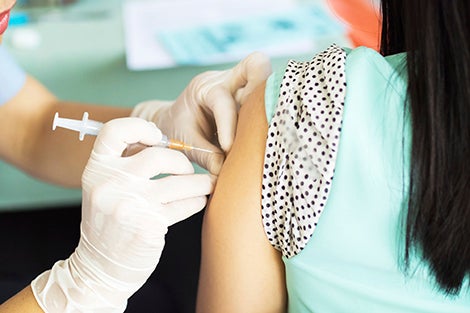March 12, 2019 – Some of the most important medications doctors have at their disposal have been rendered ineffective by parasites, viruses, and bacteria that have evolved resistance against them, and the problem is poised to get worse.
Drug-resistant strains of gonorrhea, salmonella, Escherichia coli (E. coli) and many other disease-causing agents are flourishing around the world, and the consequences are disastrous—at least 700,000 people die globally as a result of antimicrobial resistance (AMR) annually, according to a 2016 review on antimicrobial resistance commissioned by former UK Prime Minister David Cameron.
It’s a perilous situation, but several new studies from researchers at Harvard T.H. Chan School of Public Health indicate that an important tool in the fight against AMR already exists: vaccines.
The Proceedings of the National Academy of Sciences (PNAS) recently devoted a special feature section to examine the role vaccines can play in stemming the tide of AMR. In general terms, vaccinations can help lessen the burden of AMR in two ways: First, they can protect against the direct transmission of drug-resistant infections. Second, they can lessen the chances of someone getting sick, which in turn reduces the likelihood that he or she will be prescribed antibiotics or other medications. The fewer medications someone takes, the less likely it is that microbes will evolve resistance to the drugs.
“Despite the increased attention paid to vaccination as a response to AMR in recent years, it remains underemphasized in many cases,” said David Bloom, Clarence James Gamble Professor of Economics and Demography, who co-authored an overview article for the PNAS feature. “Vaccination potentially confers considerable value with regard to its ability to slow the development of antimicrobial resistance and mitigate its worst effects.”
As Bloom notes, AMR is not a new problem. Bacteria have been evolving resistance to antibiotics since the first doses of penicillin were administered back in the 1940s. In the past few decades, though, the burden of AMR has skyrocketed and there’s emerging evidence that some drug-resistant bugs are more aggressive or transmissible than their drug-susceptible counterparts.
Among the many challenges is that any use of antimicrobials, including common antibiotics, drives the evolution of resistance, even if the drugs are being used appropriately, Bloom said. Efforts to curb AMR have mostly focused on developing new antibiotics and other drugs. That’s certainly part of the solution, he said, but developing new drugs is a slow, costly process and it’s only a matter of time before the targeted parasites or bacteria begin developing resistance to the new drugs.
Vaccines are appealing because they don’t just protect individuals against germs, they protect entire communities through “herd immunity” (the more people that are vaccinated, the harder it is for germs to spread). For instance, Bloom points to drops in drug-resistant pneumococcal disease in areas where pneumococcal conjugate vaccines have been widely administered. There is also evidence showing that pathogens are much less likely to develop resistance to vaccines than they are to antimicrobial treatment—making vaccines an important first-line defense against AMR.
Promising as this sounds, there’s still much to learn about vaccines and AMR, both on the biological side and on the implementation side. To that end, PNAS featured a paper led by JP Sevilla, research associate at Harvard Chan School, that discussed the need to create a framework to assess the economic value of vaccines with regard to their impact on AMR.
Based on what’s known now, it appears that vaccinations offer significant value by addressing AMR and its associated social and economic challenges. Failing to account for AMR in economic assessments of vaccinations could mean that we are undervaluing vaccination programs and consequently underinvesting in vaccine R&D and uptake.
“Addressing AMR doesn’t require making fundamental changes to already well-developed frameworks for economically evaluating vaccines. There’s a causal chain flowing from vaccination, to its health impacts, and the economic consequences of those impacts. The economic elements of the chain—measuring vaccination costs and the economic consequences of health impacts—are the easier part,” Sevilla said. “The hardest link and highest research priority is the non-economic middle: tracing through the causal impacts of vaccination on susceptible and resistant disease.”
Another PNAS paper, co-authored by Chan School’s Marc Lipsitch, professor of epidemiology, examined how vaccines may help protect the microbiome, the collection of trillions of microorganisms throughout the body. The study noted that the microbiome appears to play an important role in helping humans mount effective immune responses to pathogens. But antimicrobials, which are often broad spectrum and don’t just target the organism that’s causing illness, could alter the microbiome and make it less effective when it comes to spurring the immune system into action.
Further exploring the interplay between vaccines and the microbiome, a paper co-authored by Harvard Chan School PhD student Christine Tedijanto, showed the extent to which bacteria that are commonly found in the microbiome are exposed to antibiotics even when they are not the target of the medication. In other words, if a patient is prescribed antibiotics for a case of pneumonia caused by Streptococcus pneumoniae (S. pneumoniae), it’s likely the antibiotics will also affect E. Coli and other naturally occurring bacteria in the person’s microbiome that are not making the person sick. This in turn increases the likelihood that those untargeted bacteria may become resistant to the antibiotics.
Tedijanto’s study showed that vaccines can help mitigate this effect. She found that pneumococcal conjugate vaccination programs, which provide protection against S. pneumoniae infection, significantly reduce the amount of antibiotics E. Coli and Staphylococcus aureus (S. aureus) are exposed to even though they’re not directly targeted by the vaccine.
While there is significant potential for vaccines to help quell the burden of AMR, Bloom said that a robust and integrated set of solutions is needed, including the development of new vaccines, new antibiotics and other medications, as well as buy-in from policymakers, the global health community, and the public at large.
Photos: istock.com
